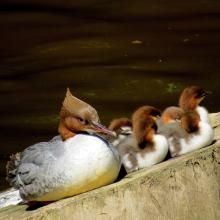
This goosander and her six chicks were enjoying the sun at lunchtime today on a stump in midstream just below Warriston Cemetery.
She can, with difficulty, be distinguished from a female red-breasted merganser by the absence of white rings around her eyes. Unlike human parents of young offspring, she also lacks dark bags under her eyes.
Goosanders only established themselves in Scotland in 1871, and spread to the north of England in 1941 and thence southwest. They are partial to fish, and use their hooked and sawtoothed bills to catch them.
Their taxonomic name Mergus merganser derives from the 17th-century Latin word mergere – to dive and anser – a goose. This is not enormously helpful since goosanders are ducks.
